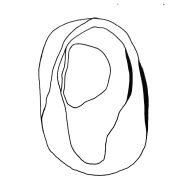Eiko has been “in residency” at the Cathedral of St. John the Divine since September. In addition to her photo and video exhibition being on view as part of the Christa Project, Eiko has been experimenting and practicing her solo project. To find out when she will be rehearsing, follow her on social media (you can do so by clicking the icons at the end of this newsletter).
I came to the Cathedral for the first time today. This note is from her open rehearsal on Saturday November 12 at 11am, one of twelve that she has done this fall:
I didn’t speak with Eiko about the results of the election until this morning. As we organized our things before her performance in a supply closet of the Cathedral of St. John the Divine, I asked her if I should still post what we had planned, or if she wanted to express the emotions she was feeling over the past few days. She matter of factly undressed, tossing aside her street clothes, while she told me that we couldn’t continue as if nothing had happened. As she wrapped herself in two layers of white kimonos, she tasked me with watching her perform and reflecting on the election, on her body, on this space we were in. She wanted to hear my personal thoughts.
I watched intently, as I had many times as her student, as Eiko transformed from her energetic, fast-moving self into her measured, serious performance state. Her eyes turned inward, and then upward to the cavernous ceilings of the Cathedral. She focused solely on the flexing of a toe reaching down the steps from the apse. She slid her body heavily on the cold marble to descend into the nave. How often do we get to concentrate so dedicatedly on the movement of our toe and its meaning? How often does the journey down three stairs take three minutes? I felt envious. As someone who has always found solace in movement, I craved that opportunity to move slowly and deliberately in a space that seems to beg for movement. Eiko contorted her face in apparent pain, apparent anger, apparent despair. She sung out as the enormous red cloth she totes tore on her sandal with a surprisingly loud “rrriiiiippp.” How I had been longing to weep in front of people this week, to cry out in a place that would make it loud – that would make it echo! I connected with Eiko’s performance today in a way that I hadn’t before… I wanted to join her.
I felt that Eiko’s “peculiar” performance style was both cathartic and instructive, for me and for others there.
A woman and her son who had stumbled upon the performance while touring the Cathedral came up to Eiko to ask her questions and share their thoughts after she had finished. Ben, the son, told her he felt the desire to help her as she performed, to ask her if she was alright. The mother asked, “do you ever depict joy?” Eiko answered, “I am generally a joyous person, I love living and I love working. So for me the performance is a transformation from my usual self.” She went on to say that people often try to help her during her site performances because she “looks so pitiful.” But, she says, she “likes that helplessness… that helplessness is in the world.”
I found that observing Eiko’s performance of helplessness without trying to fix it – purposefully letting it flower and exist with no move to resolve it – was meditative and even satisfying. So rarely do we hold space for those feelings without attempting to cure them.
Eiko’s movement, though, was not simply an expression of despair or hopelessness in the face of troubling power. It was (and, really, it always has been) an often overlooked political stance against rashness. It is the argument for hesitation. Eiko emphasizes this word in her class at Wesleyan as a mantra for her movement and as a political agenda. Hesitate. I interpret this to mean acting with a caring thoughtfulness that breeds meaningful movement. Even in a moment that I saw as angry in her dancing, when Eiko’s sandal slapped the marble floor with a shocking loud “snap,” there existed thoughtfulness and deliberateness in this singular sound – it called our attention to the sharpness that exists among Eiko’s smooth slow moves.
I feel now a little more ready to make my anger and despair meaningful.
